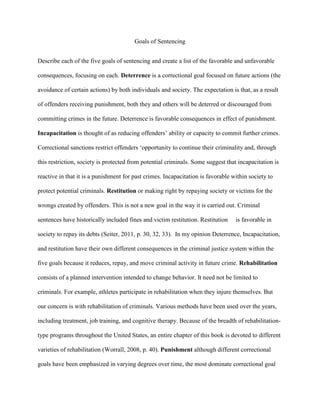
Five Goals of Sentencing: Deterrence, Incapacitation, Restitution, Rehabilitation, Punishment
- 1. Goals of Sentencing Describe each of the five goals of sentencing and create a list of the favorable and unfavorable consequences, focusing on each. Deterrence is a correctional goal focused on future actions (the avoidance of certain actions) by both individuals and society. The expectation is that, as a result of offenders receiving punishment, both they and others will be deterred or discouraged from committing crimes in the future. Deterrence is favorable consequences in effect of punishment. Incapacitation is thought of as reducing offenders’ ability or capacity to commit further crimes. Correctional sanctions restrict offenders ‘opportunity to continue their criminality and, through this restriction, society is protected from potential criminals. Some suggest that incapacitation is reactive in that it is a punishment for past crimes. Incapacitation is favorable within society to protect potential criminals. Restitution or making right by repaying society or victims for the wrongs created by offenders. This is not a new goal in the way it is carried out. Criminal sentences have historically included fines and victim restitution. Restitution is favorable in society to repay its debts (Seiter, 2011, p. 30, 32, 33). In my opinion Deterrence, Incapacitation, and restitution have their own different consequences in the criminal justice system within the five goals because it reduces, repay, and move criminal activity in future crime. Rehabilitation consists of a planned intervention intended to change behavior. It need not be limited to criminals. For example, athletes participate in rehabilitation when they injure themselves. But our concern is with rehabilitation of criminals. Various methods have been used over the years, including treatment, job training, and cognitive therapy. Because of the breadth of rehabilitation- type programs throughout the United States, an entire chapter of this book is devoted to different varieties of rehabilitation (Worrall, 2008, p. 40). Punishment although different correctional goals have been emphasized in varying degrees over time, the most dominate correctional goal
- 2. has historically been punishment, the infliction of pain or suffering. As a society, we believe that punishment for inappropriate behavior is not only allowable, but also advisable. Criminal offenders are brought to justice by the state, acting for society (Seiter, 2011, p. 28). Rehabilitation, and punishment are unfavorable consequences in criminal behavior and some parolees can fall back into crime life or relapse because they can’t help themselves into societies misleading issues. (Deterrence, Incapacitation, and restitution are favorable—Rehabilitation, and punishment are unfavorable) and all five goals are different in the criminal justice system through the eyes of criminals behavior offenders. References Seiter, R. (2011). Corrections. An Introduction. (3rd ed) Prentice Hall Worrall, J. (2008). Crime Control in America. What Works? (2nd ed) Pearson Allyn and Bacon
